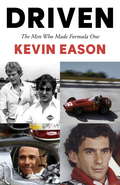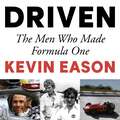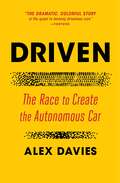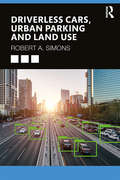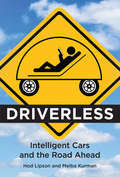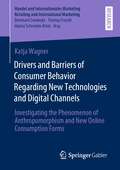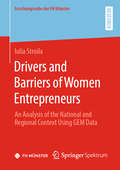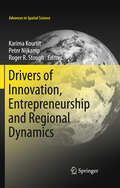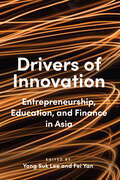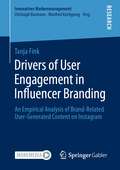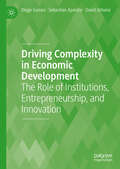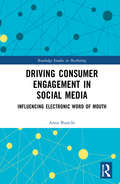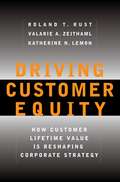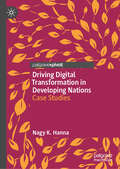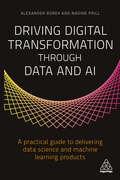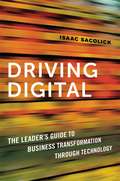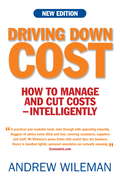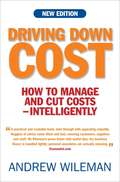- Table View
- List View
Driven: The Men Who Made Formula One
by Kevin EasonFormula One is speed, glamour, danger - and eye-watering wealth. Driven: The Men Who Made Formula One tells how a small group of extraordinary men transformed Formula One from a niche sport played out on primitive tracks surrounded by hay bales and grass verges into a £1 billion circus performing in vast theatres of entertainment all over the world.Led by Bernie Ecclestone, the billionaire ringmaster, this clique started by scraping a living to go racing and ended up creating space-age cars, turning drivers from amateur gladiators into multimillion-pound superstars, like Ayrton Senna and Lewis Hamilton, while the names of Ferrari, McLaren and Williams are now as familiar around the world as Manchester United or Real Madrid. For 20 years, Kevin Eason watched how these men operated like a sporting Mafia, protecting each other while squabbling over the vast wealth pouring into the sport. As motor racing correspondent for The Times and then with The Sunday Times, Eason was privileged to have a ringside seat as this cabal of wealthy characters ruled and then were pushed out of the sport they created. This colourful and compelling account of the extraordinary flourishing of Formula One explores the quirks and extravagances of the men who converged - in one generation - to shape their sport; disparate characters with a common impulse: they were racers - and they were driven.
Driven: The Men Who Made Formula One
by Kevin EasonDelve into the murky world of Formula 1 - a world where money, fame and power rules - but for how long?Formula One is speed, glamour, danger - and eye-watering wealth. Driven: The Men Who Made Formula One tells how a small group of extraordinary men transformed Formula One from a niche sport played out on primitive tracks surrounded by hay bales and grass verges into a £1 billion circus performing in vast theatres of entertainment all over the world.Led by Bernie Ecclestone, the billionaire ringmaster, this clique started by scraping a living to go racing and ended up creating space-age cars, turning drivers from amateur gladiators into multimillion-pound superstars, like Ayrton Senna and Lewis Hamilton, while the names of Ferrari, McLaren and Williams are now as familiar around the world as Manchester United or Real Madrid. For 20 years, Kevin Eason watched how these men operated like a sporting Mafia, protecting each other while squabbling over the vast wealth pouring into the sport. As motor racing correspondent for The Times and then with The Sunday Times, Eason was privileged to have a ringside seat as this cabal of wealthy characters ruled and then were pushed out of the sport they created. This colourful and compelling account of the extraordinary flourishing of Formula One explores the quirks and extravagances of the men who converged - in one generation - to shape their sport; disparate characters with a common impulse: they were racers - and they were driven.(P)2018 Hodder & Stoughton Limited
Driven: The Race to Create the Autonomous Car
by Alex DaviesAlex Davies tells the &“illuminating and important narrative&” (Steven Levy, author of Facebook: The Inside Story) of the quest to develop driverless cars—and the fierce competition between Google, Uber, and other companies in a race to revolutionize our lives.The self-driving car has been one of the most vaunted technological breakthroughs of recent years. But early promises that these autonomous vehicles would soon be on the roads have proven premature. Alex Davies follows the twists and turns of the story from its origins to today. The story starts with the Defense Advanced Research Projects Agency (DARPA), which was charged with developing a land-based equivalent to the drone, a vehicle that could operate in war zones without risking human lives. DARPA issued a series of three &“Grand Challenges&” that attracted visionaries, many of them students and amateurs, who took the technology from Jetsons-style fantasy to near-reality. The young stars of the Challenges soon connected with Silicon Valley giants Google and Uber, intent on delivering a new way of driving to the civilian world. Soon the automakers joined the quest, some on their own, others in partnership with the tech titans. But as road testing progressed, it became clear that the challenges of driving a car without human assistance were more formidable than anticipated. Davies profiles the industry&’s key players from the early enthusiasm of the DARPA days to their growing awareness that while this spin on artificial intelligence isn&’t yet ready for rush-hour traffic, driverless cars are poised to remake how the world moves. Driven explores &“the epic tale of competition and comradery, long odds and underdogs, all in service of a world-changing moonshot&” (Andy Greenberg, author of Sandworm: A New Era of Cyberwar).
Driver Training for Automated Vehicles: A Systems Approach (ISSN)
by Neville A. Stanton Katherine L. Plant Kirsten M. Revell Siobhán E. MerrimanSince the introduction of Automated Vehicles (AVs) on roads, there have been a number of high-profile collisions, which have highlighted significant driver challenges. These include challenges associated with drivers’ trust in the automation, their knowledge and awareness of the AV’s capabilities and limitations and their reduced situation awareness of the road environment and the vehicle. Solutions are needed to overcome these challenges, so that the expected benefits of AVs can be realised.Driver Training for Automated Vehicles: A Systems Approach identifies the training requirements for drivers of AVs and takes a systematic approach to design, develop, implement and evaluate a comprehensive training package to address these requirements. This book explores how training can overcome the driver challenges associated with AVs by improving drivers’ mental models, trust in automation, decisions and behaviour when activating a Level 4 AV. It presents a systematic approach to the training lifecycle, by first presenting the current state of research into AVs, identifying the challenges and training requirements for drivers of AVs, and then developing and evaluating a training programme to achieve these requirements. This fascinating title highlights the need for drivers to undergo training for AVs, and takes us a step closer to this need. It walks readers through a systematic, four-step process and provides practical guidance to develop and evaluate an effective training programme. The reader will develop a thorough understanding of the current driver challenges with AVs and the methods and systems to mitigate them through current knowledge and research.This book is an ideal read for practitioners, designers and academics with a professional or research interest in AVs. Its appeal extends to those in the fields of automotive design, Systems Engineering, Human Factors and education and training.
Driverless Cars, Urban Parking and Land Use
by Robert A. SimonsThe subject of driverless and even ownerless cars has the potential to be the most disruptive technology for real estate, land use, and parking since the invention of the elevator. This book includes new research and economic analysis, plus a thorough review of the current literature to pose and attempt to answer a number of important questions about the effect that driverless vehicles may have on land use in the United States, especially on parking. Simons outlines the history of disruptive technologies in transport and real estate before examining how the predicted changes brought in by the adoption of driverless technologies and decline in car ownership will affect our urban areas. What could we do with all the parking areas in our cities and our homes and institutional buildings that may no longer be required? Can they be sustainably repurposed? Will self-driving cars become like horses, used only by hobbyists for recreation and sport? While the focus is on parking, the book also contains the views of real estate economists, architects, and policymakers and is essential reading for real estate developers and investors, transport economists, planners, politicians, and policymakers who need to consider the implications of a future with more driverless vehicles. Fasten your seat belt: like it or not, driverless cars will begin to change the way we move about our cities within ten years.
Driverless: Intelligent Cars and the Road Ahead
by Hod Lipson Melba KurmanWhen human drivers let intelligent software take the wheel: the beginning of a new era in personal mobility. Google's newest driverless car had no steering wheel and no brakes. The message was clear: cars of the future will be born fully autonomous, with no human driver needed. In the coming decade, self-driving cars will hit the streets, rearranging established industries and reshaping cities, giving us new choices in where we live and how we work and play.In this book, Hod Lipson and Melba Kurman offer readers insight into the risks and benefits of driverless cars and a lucid and engaging explanation of the enabling technology. Recent advances in software and robotics are toppling long-standing technological barriers that for decades have confined self-driving cars to the realm of fantasy. A new kind of artificial intelligence software called deep learning gives cars rapid and accurate visual perception. Human drivers can relax and take their eyes off the road. When human drivers let intelligent software take the wheel, driverless cars will offer billions of people all over the world a safer, cleaner, and more convenient mode of transportation. Although the technology is nearly ready, car companies and policy makers may not be. The authors make a compelling case for why government, industry, and consumers need to work together to make the development of driverless cars our society's next “Apollo moment.”
Drivers and Barriers of Consumer Behavior Regarding New Technologies and Digital Channels: Investigating the Phenomenon of Anthropomorphism and New Online Consumption Forms (Handel und Internationales Marketing Retailing and International Marketing)
by Katja WagnerKatja Wagner investigates consumer behavioral intention and interactions with new technologies and digital channels. Due to the fact that the development, spread and sale of these new technologies and digital channels will have a continuous growth and influence in the following years regarding business activities, it is important to take a deeper look in the areas of artificial intelligence and e-commerce. Not only business is affected from these new shifts, but it also impacts consumers’ attitudes, motivation, and practices. So, the evaluation of anthropomorphism and in general, the expectation and motivation of successful acceptance are under review and offer explanations for consumers intentional usage of new technologies. Therefore, six essays address specific phenomena in central subareas of new technologies and digital channels for a more profound understanding of consumers in digital environments.
Drivers and Barriers of Women Entrepreneurs: An Analysis of the National and Regional Context Using GEM Data (Forschungsreihe der FH Münster)
by Iulia StroilaThe number of women entrepreneurs is growing rapidly worldwide, however, women are still less likely than men to start a new business. Two factors influencing this are barriers and drivers, however, the understanding of how their interaction affects women’s entrepreneurial intention, specifically across different contexts, is lacking. This study focuses on entrepreneurial intention of women across four different European countries, by adopting both a national and supranational perspective. The analysis is based on the Global Entrepreneurship Monitor (GEM) Germany, Poland, Spain, and Sweden 2015 database. Overall the thesis contributes to the literature of entrepreneurship and context and also the understanding of factors influencing women entrepreneurship in Europe.
Drivers of Environmental Change in Uplands (Routledge Studies in Ecological Economics)
by Jon Stewart Aletta Bonn Tim Allott Klaus HubacekThe uplands are a crucial source of ecosystem services, such as water provision, carbon retention, maintenance of biodiversity, provision of recreation value and cultural heritage. This puts them in the focus of both environmental and social scientists as well as practitioners and land managers.. This volume brings together a wealth of knowledge of the British uplands from diverse but interrelated fields of study, clearly demonstrating their importance in 21st Century Britain, and indicating how we may through interdisciplinary approaches meet the challenges provided by past and future drivers of environmental change.The upland environments are subject to change. They face imminent threats as well as opportunities from pressures such as climate change, changes in land management and related changes in fire risk, increases in erosion and water colour, degradation of habitats, altered wildlife and recreational value, as well as significant changes in the economy of these marginal areas. This book presents up-to-date scientific background information, addresses policy related issues and lays out pressing land management questions. A number of world-class experts provide a review of cutting-edge naturaland social science and an assessment of past, current and potential future management strategies, policies and other drivers of change. After appraisal of key concepts and principles, chapters provide specific examples and applications by focussing on UK upland areas and specifically the Peak District National Park as a key example for other highly valuable upland regions.
Drivers of Industry Financial Structure
by Indra A. Reinbergs Dwight B. CraneThis case contains common-size balance sheets and financial ratios for 10 companies, each representative of a different industry. Students are asked to identify the industries from the structure of the financial statements.
Drivers of Innovation, Entrepreneurship and Regional Dynamics
by Roger R. Stough Peter Nijkamp Karima KourtitThe need for informed and effective insights into key concepts and models of regional development and growth, from an endogenous growth perspective, has risen over the past decade. These recent advances address in particular local and regional assets and characteristics comprising inter alia creativity, knowledge, innovation forces and entrepreneurship. Access to and exploitation of these modern forms of human and social capital are of paramount importance for the dynamic regional economic environment in a city or region. This volume offers an overview and critical treatment of the spatial-economic roots, opportunities and impacts of new growth strategies, mainly from an evidence-based perspective. In the various contributions to this volume, relevant findings and strategic options are interpreted and discussed from both an analytical and a policy perspective to help cultivate creativity, human capital development and innovation as well as entrepreneurial activity, with a view to exploit the drivers of economic development, in order to strengthen the competitive edge of cities and regions.
Drivers of Innovation: Entrepreneurship, Education, and Finance in Asia
by Yong Suk Lee and Fei YanInnovation and entrepreneurship rank highly on the strategic agenda of most countries today. As global economic competition intensifies, many national policymakers now recognize the central importance of entrepreneurship education and the building of financial institutions to promote long-term innovation, entrepreneurship, and economic growth. Drivers of Innovation brings together scholars from the United States and Asia to explore those education and finance policies that might be conducive to accelerating innovation and developing a more entrepreneurial workforce in East Asia. Some of the questions covered include: How do universities in China and Singapore experiment with new types of learning in their quest to promote innovation and entrepreneurship? Is there a need to transform the traditional university into an "entrepreneurial university"? What are the recent developments in and outstanding challenges to financing innovation in China and Japan? What is the government's role in promoting innovative entrepreneurship under the shadow of big business in South Korea? What can we learn about the capacity of services to drive innovation-led growth in India? Drivers of Innovation will serve as a valuable reference for scholars and policymakers working to develop human capital for innovation in Asia.
Drivers of User Engagement in Influencer Branding: An Empirical Analysis of Brand-Related User-Generated Content on Instagram (Innovatives Markenmanagement)
by Tanja FinkThe knowledge on how to influence user engagement metrics and thereby brand visibility plays a crucial role in influencer branding – both for social media influencers as well as marketers. Based upon two holistic empirical models and the analysis of real-world data, Tanja Fink is able to show important drivers of user engagement in influencer branding. Therefore, the author is building upon established models from research in celebrity endorsement, product placement and social media marketing. The profound empirical results reveal surprising and highly relevant insights for brand managers which call for a more conscientious (visual) integration of brands in user-generated content (UGC) on Instagram. In addition, the author detects several mechanisms for increasing user engagement while preventing user reactance towards the brand endorsement.
Drivers of Value Capture
by Eric J. Van Den SteenThis note introduces a framework for analyzing value capture (through bargaining and pricing) and bargaining advantage (or value capture advantage), i.e., a firm's (superior) ability to capture a share from the value it helps create.
Drivers of Value Creation
by Eric J. Van Den SteenThis note introduces a concise but comprehensive framework for analyzing value creation and value creation advantage, i.e., a firm's superior ability to increase the spread (or gap) between its offering's customer value (or WTP) and supplier cost (or WTS). (While the framework applies more broadly, it was developed as a component of the PVA framework.)
Driving Complexity in Economic Development: The Role of Institutions, Entrepreneurship, and Innovation
by David Urbano Sebastian Aparicio Diego GomezThis book analyzes the role of institutions in conditioning entrepreneurship and innovation to achieve economic development.Set against the backdrop of populism, this book is based on the premise that formal and informal institutional factors and entrepreneurship are closely linked and that studying the economic development of both developed and emerging economies can help us disentangle the role of entrepreneurship and innovation in developing countries.Using institutional economics as a main theoretical framework and the sociotechnical subsystems as a complementary approach, the authors present a detailed literature review to demonstrate that it is possible to identify the true role of entrepreneurship and innovation in the economic development process. The book embraces complexity to better measure and comprehend economic development, bringing a more compelling perspective on the importance of entrepreneurship and innovation for different dimensions of development.A valuable resource for students, scholars, and policymakers, the authors offer clear recommendations for developing countries.
Driving Consumer Engagement in Social Media: Influencing Electronic Word of Mouth (Routledge Studies in Marketing)
by Anna BianchiSummarizing the extant research on marketing communications, social media and word of mouth, this book clarifies terms often incorrectly and interchangeably used by scholars and marketers and provides principles of effective marketing communications in social media for different brand types and in different geographic markets. Conversations among consumers on social media now have an unprecedented ability to shape attitudes toward people, products, services, brands and to influence buying decisions. Consequently, the digital era brings to the fore the importance of interpersonal relations and the power of personal recommendations. This book is the first to empirically investigate how the form and appeal of marketing communications in social networks influence electronic word of mouth, including an examination of brand type and geographic market. The author focuses on motivations and reveals why people exchange opinions about brands, products and services in the digital environment. The book summarizes the existing research on marketing communications, social media and word of mouth, provides a cutting-edge knowledge based on the analysis of the actual behavior of consumers and rules of effective marketing communications in social media. This research-based book is written for scholars and researchers within the fields of marketing and communication. It may also be of interest to a wider audience interested in understanding how to use social media to influence electronic word of mouth.
Driving Corporate Growth with the Right Disciplines: A Discovery-Driven Approach
by Ian C. Macmillan Rita Gunther McgrathDespite its centrality, driving corporate growth is paradoxical--everyone recognizes its importance, yet it is easy to get it wrong. The result is that every day, anxious executives in well-established companies worry deeply about how they are going to lead strategic growth in their organizations. The time-tested, comfortable approaches to everyday management don't work well in rapidly changing, uncertain environments. This chapter outlines a new approach--discovery-driven growth--and demonstrates how it allows you to harness the essential discovery process required in high-uncertainty situations so that you can benefit from it. This chapter is excerpted from "Discovery-Driven Growth: A Breakthrough Process to Reduce Risk and Seize Opportunity."
Driving Customer Equity
by Valarie A. Zeithaml Roland T Rust Katherine N LemonIn their efforts to become more customer-focused, companies everywhere find themselves entangled in outmoded systems, metrics, and strategies rooted in their product-centered view of the world. Now, to ease this shift to a customer focus, marketing strategy experts Roland T. Rust, Valarie A. Zeithaml, and Katherine N. Lemon have created a dynamic new model they call "Customer Equity," a strategic framework designed to maximize every firm's most important asset, the total lifetime value of its customer base. The authors' Customer Equity Framework yields powerful insights that will help any business increase the value of its customer base. Rust, Zeithaml, and Lemon introduce the three drivers of customer equity -- Value Equity, Brand Equity, and Retention Equity -- and explain in clear, nontechnical language how managers can base their strategies on one or a combination of these drivers. The authors demonstrate in this breakthrough book how managers can build and employ competitive metrics that reveal their company's Customer Equity relative to their competitors. Based on these metrics, they show how managers can determine which drivers are most important in their industry, how they can make efficient strategic trade-offs between expenditures on these drivers, and how to project a financial return from these expenditures. The final section devotes two chapters to the Customer Pyramid, an approach that segments customers based on their long-term profitability, and an especially important chapter examines the Internet as the ultimate Customer Equity tool. Here the authors show how companies such as Intuit.com, Schwab.com, and Priceline.com have used more than one or all three drivers to increase Customer Equity. In this age of one-to-one marketing, understanding how to drive Customer Equity is central to the success of any firm. In particular, Driving Customer Equity will be essential reading for any marketing manager and, for that matter, any manager concerned with growing the value of the firm's customer base.
Driving Digital Transformation in Developing Nations: Case Studies
by Nagy K. HannaThis book provides detailed insight into what governments and institutions can do to drive digital transformation in a nation pursuing economic development. Drawing on real-world case studies and practical advice, the book breaks down digital transformation of public services, healthcare, and the move toward smart cities. Synthesizing publicly available information, the book captures how the World Bank transformed its response to the digital revolution in several nations. Nagy K. Hanna takes readers through the pioneering export strategy of software services in India’s and Sri Lanka’s first integrated digital transformation program. The resulting book is a guide for policymakers, development economists, and change-makers seeking new ways to harness the power of digital technologies to promote inclusive and sustainable development.
Driving Digital Transformation through Data and AI: A Practical Guide to Delivering Data Science and Machine Learning Products
by Alexander Borek Nadine PrillLeading tech companies such as Netflix, Amazon and Uber use data science and machine learning at scale in their core business processes, whereas most traditional companies struggle to expand their machine learning projects beyond a small pilot scope. This book enables organizations to truly embrace the benefits of digital transformation by anchoring data and AI products at the core of their business. It provides executives with the essential tools and concepts to establish a data and AI portfolio strategy as well as the organizational setup and agile processes that are required to deliver machine learning products at scale. Key consideration is given to advancing the data architecture and governance, balancing stakeholder needs and breaking organizational silos through new ways of working. Each chapter includes templates, common pitfalls and global case studies covering industries such as insurance, fashion, consumer goods, finance, manufacturing and automotive. Covering a holistic perspective on strategy, technology, product and company culture, Driving Digital Transformation through Data and AI guides the organizational transformation required to get ahead in the age of AI.
Driving Digital: The Leader's Guide to Business Transformation Through Technology
by Isaac SacolickEvery organization makes plans for updating products, technologies, and business processes. But that&’s not enough anymore for the twenty-first-century company. The race is now on for everyone to become a digital enterprise. For those individuals who have been charged with leading their company&’s technology-driven change, the pressure is intense while the correct path forward unclear. Help has arrived! In Driving Digital, author Isaac Sacolick shares the lessons he&’s learned over the years as he has successfully spearheaded multiple transformations and helped shape digital-business best practices. Readers no longer have to blindly trek through the mine field of their company&’s digital transformation. In this thoroughly researched one-stop manual, learn how to: • Formulate a digital strategy • Transform business and IT practices • Align development and operations • Drive culture change • Bolster digital talent • Capture and track ROI • Develop innovative digital practices • Pilot emerging technologies • And more! Your company cannot avoid the digital disruption heading its way. The choice is yours: Will this mean the beginning of the end for your business, or will your digital practices be what catapults you into next-level success?
Driving Down Cost
by Andrew WilemanWith over twenty-five years of experience in consulting, plus the knowledge of having run over fifty cost-reduction projects internationally, author Andrew Wileman offers a management toolkit for analyzing cost. This in-depth look at how to reduce cost offers tips and tricks and the sneaky, smart ways to turn cost into revenue.
Driving Down Cost: How to Manage and Cut Cost - Intelligently
by Andrew WilemanDrawing on over 25 years consultancy experience running over 50 big one-time, cost-reduction projects internationally, Wileman provides a Cost Management Toolkit of key ideas and cost management strategies for analysing cost-management including procurement and management accounts and looks at how the leadership team needs to take the lead and set the tone on cost. He lays out a set of ideas, approaches, tips and tricks that have worked for him and looks at the sneaky ways cost can be created and the even sneakier, smart ways they can be cut - like getting your customers to do your work for you, or turning cost into revenue. Packed with real-life, international case studies and practical techniques for implementing cost reduction programmes in a period of chaos in the markets and worldwide recession, this new edition could not be more timely.
Driving Down Cost: How to Manage and Cut Cost - Intelligently
by Andrew WilemanDrawing on over 25 years consultancy experience running over 50 big one-time, cost-reduction projects internationally, Wileman provides a Cost Management Toolkit of key ideas and cost management strategies for analysing cost-management including procurement and management accounts and looks at how the leadership team needs to take the lead and set the tone on cost. He lays out a set of ideas, approaches, tips and tricks that have worked for him and looks at the sneaky ways cost can be created and the even sneakier, smart ways they can be cut - like getting your customers to do your work for you, or turning cost into revenue. Packed with real-life, international case studies and practical techniques for implementing cost reduction programmes in a period of chaos in the markets and worldwide recession, this new edition could not be more timely.
